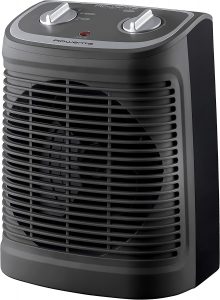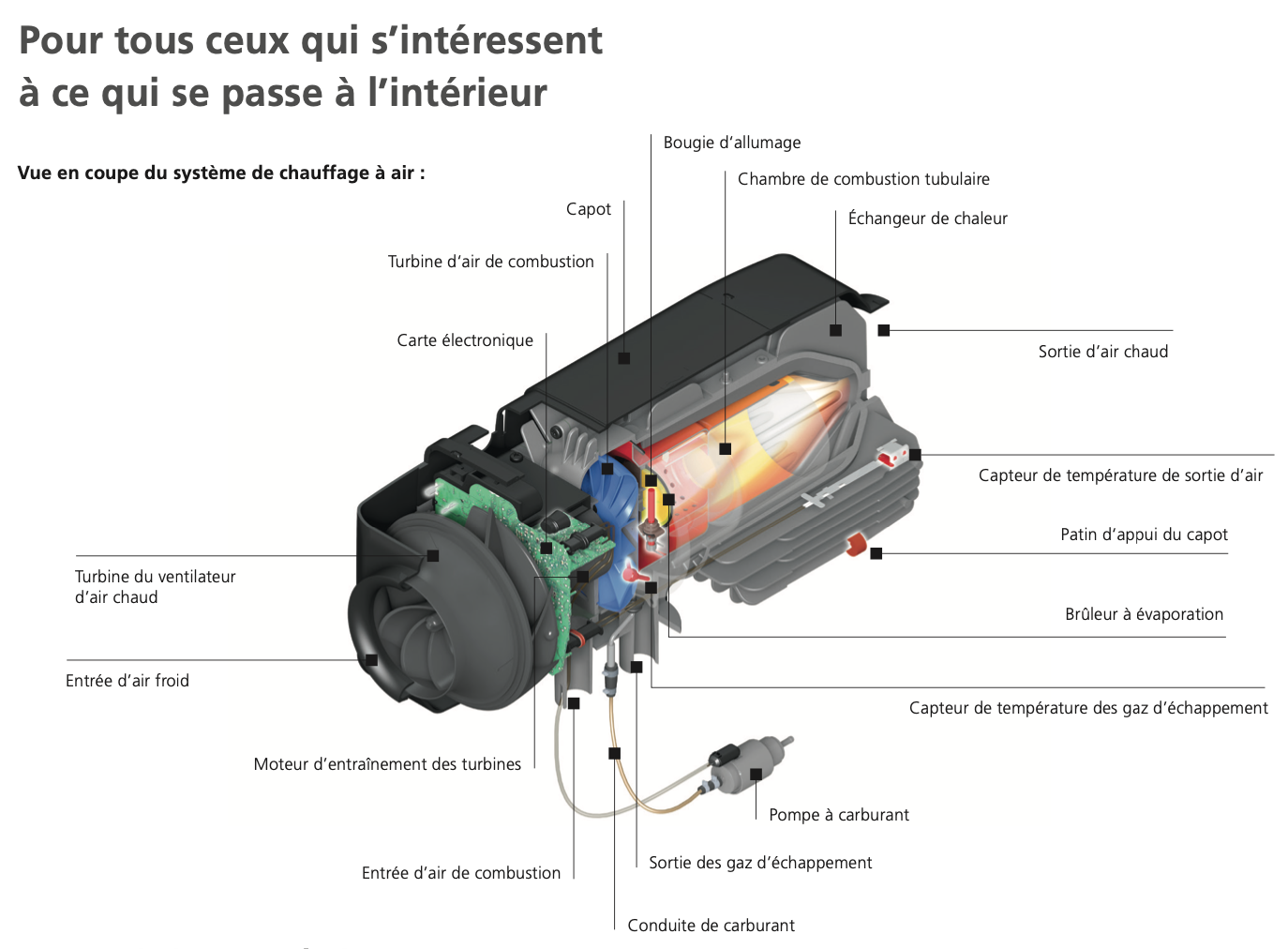The issue of heater often comes up when talking aboutfitting out a van or fitted out van. For who wants travel outside the summer period, in the heart of winter, or go on the roads all year round, this additional comfort can quickly become a little essential “luxury”. But which heating solution to choose?
Fixed or mobile, as for a traditional house, several answers are possible according to the budget and the project.
For our part, after two years on the roads without heating with our VW T3, "Popo", we had finally decided to install one but made the wrong choice when it came to this precious equipment. Finally, let's say that the solution was good, but not the product… And yes it happens, that's how you learn. A more economical and half-considered choice that did not last over time.
After some research, several solutions were available to us. And ours, for our use, was therefore all found… or almost if we hadn't made the mistake of not paying the price right away.
Several brands offer this type of heater. If the shape and the power of the device vary, the principle remains the same: it is the gas burning who will power the machine like a domestic boiler but here connected to the gas cylinder of the van, van or motorhome.
heated air is then sent into the passenger compartment thanks to a turbine / fan, we are talking aboutforced air.

Depending on the models, installation can be done inside the vehicle or under the chassis (with a box). The heating power can be adjusted via a potentiometer, or for high-end models, via a smart thermostat. The installation is quite simple and also requires connect to 12V, however, it will be necessary make sure there are no leaks, (especially with installation inside the passenger compartment), and above all good ventilation!
According to U.S, the big disadvantage of this solution is the gas consumption. With a small bottle, hard to spend more than a warm weekend… and even. A viable solution despite everything, but therefore rather for large vehicles with enough space to carry two large gas bottles (just to last a week and to have a reserve for the kitchen in particular), or for outings limited to a weekend here and there.
This type of heating is approved for use by the vehicle in VASP as soon as it is installed by a professional.
Small variant, still on gas but this time without fixed installation. These mobile radiant heaters are back-up solutions which do not require no electrical connection. Existing in many shapes and sizes, they are not not originally designed to be used in a van but rather outdoors or in tents, these heaters use conventional gas cartridges found in commerce. There are no big gas bottles here. The big disadvantage is that this type of heating consumes a lot of oxygen and even if they are equipped with a safety sensor which cuts the latter in case of lack, it will therefore be necessary to leave a window slightly open if used indoors... Find the mistake… Not expensive to buy, which helps out well, and practical depending on the case, but can be dangerous if you do not follow the recommendations in the rule (risk of burns, setting fire to a curtain or other, etc.). Too dangerous for us in a small space but why not being careful to troubleshoot.
In short, not very viable in the long term and there again, consumption is important since a cartridge lasts on average 3 hours.
Everyone knows them, they are the small household space heaters, but does it really work in a van? This is theoretically possible but it is, again, not not viable unless you have a huge auxiliary battery (which will be empty after an hour or two no matter what) and a 12/220V converter which holds up since this type of heating generally does at least 1000W... Much too greedy in electricity therefore. Nevertheless, if one is accustomed to going at the campsite or snow caravan with electrical connection option, they can be a solution (not very ecological certainly) in this specific case. Its use is therefore limited. to a fairly targeted use, but when you're never at the campsite like us, obviously this is not the solution.
After making the mistake of buying a low-end heater (see box below), we chose to install a Webasto AirTop 2000 STC heater : reliable and quality!
See our heating installation video, here.
Everyone knows the domestic oil boilers that we find in most houses in France (even if the tendency is to replace them for more ecological systems), and well here, to imagine, we are on the same principle Operating.
A mini boiler finds its place in the vehicle powered by either petrol or diesel (depending on what is used for the vehicle), and collects the fuel directly from the tank (via a plunger or a T). The advantage: only one energy on board! So no headache, we always have fuel (normally where then it is that one runs out of gas at the side of the road, but that's another matter), and if one uses the plunger in the tank, it always leaves a reserve for the engine. So we will start whatever happens in the morning. But rest assured, consumption is only around 100ml/hour per Kw, which is really not much! Ideal solution to be as independent as possible.
As with gas systems, the Webasto AirTop box (also much smaller), installs inside the passenger compartment at floor level (or under the chassis in a waterproof box). The system is very safe, because everything about the boiler / combustion part is not directly related to the passenger compartment. The air intake for combustion is under the chassis, the exhaust too. Inside, only the air circuit is connected: a fresh air intake and one or more hot air outlets. So no risk!
Especially since the many sensors are there to detect the slightest anomaly and would cut off the heating in the event of a problem. Connected to 12V to operate the turbine/fan that circulates air and to start the system, power consumption is also very low. What to hold wide All night long even on the smallest batteries on the market.


For our part, we never use it at night because we are not very chilly. But only in the evening when landing until bedtime and waking up. If the temperature drops below 0°C at night, we can program the heating so that it turns on automatically once or twice for 30 minutes, just to raise the temperature of the passenger compartment a little.
For this, we have taken as an option the Multicontrol thermostat which allows, among other things programming, altitude management and more precise temperature adjustment than the classic thermostat / potentiometer.
This type of heating, in addition to existing in petrol and diesel versions, is available in two powers: 2kW for small vans and vans and 5kW for very large vans and motorhomes. It is therefore not surprising that they are often found as standard on certain models of vehicles fitted out by major manufacturers. And it is quite possible to have one installed aftermarket with VASP approval of course.
To be approved VASP the installation must be made or validated by an approved professional.
For frequent travellers: as long as you have hotplates that also run on diesel (yes that exists, still at Webasto), you can completely do without gas, a big plus for long-distance trips where, as we know, the gas can be complicated to find or requires adapters (if you are equipped with LPG) or other bottles altogether.
For a long time, we thought such equipment was non-essential, a luxury. But it turned out to become a real need for us who travel and live year-round in a van and this whatever the season or the situation. It's not a legend, each task requires more organization and time in an equipped vehicle and the lack of comfort in cold weather can often lead choose the easy way: throw yourself under the duvet. In short, a little heat allows us to enjoy a little more of our interior when the weather is bad outside but also and above all to work properly from our houses on wheels. This big plus to remedy the short, unproductive winter days at the time and quickly paid for itself!
With or without heating, don't forget to equip yourself with a carbon monoxide detector and a gas detector, or even better a all purpose detector !

> Do not hesitate to ask your questions in the comments, we will be happy to answer them <









